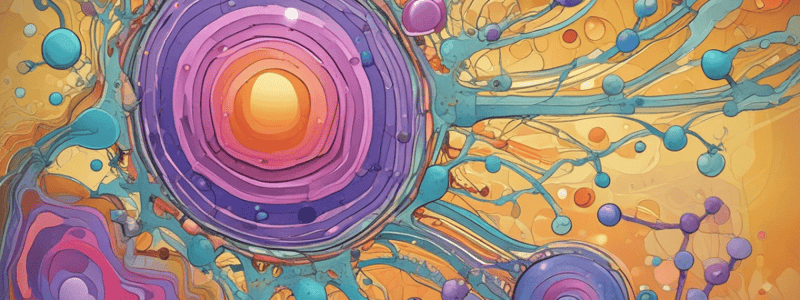Podcast
Questions and Answers
What is the primary function of ATP in cellular metabolism?
What is the primary function of ATP in cellular metabolism?
- To serve as energy currency (correct)
- To synthesize proteins
- To store genetic information
- To replicate DNA
The standard free energy of hydrolysis of ATP is -15.5 kJ/mol.
The standard free energy of hydrolysis of ATP is -15.5 kJ/mol.
False (B)
What is the effect of ATP hydrolysis on electrostatic repulsion?
What is the effect of ATP hydrolysis on electrostatic repulsion?
It relieves electrostatic repulsion
The concentrations of ATP, ADP, and Pi in the cell are not only unequal but much lower than the standard ___________ concentrations.
The concentrations of ATP, ADP, and Pi in the cell are not only unequal but much lower than the standard ___________ concentrations.
What is the result of ATP hydrolysis on the pH of the medium?
What is the result of ATP hydrolysis on the pH of the medium?
Match the following components of ATP with their descriptions:
Match the following components of ATP with their descriptions:
What is the term for the transfer of a phosphate group from one molecule to another?
What is the term for the transfer of a phosphate group from one molecule to another?
The actual free energy of hydrolysis of ATP under intracellular conditions (ΔGp) is the same as the standard free energy change in standard conditions (ΔG’o).
The actual free energy of hydrolysis of ATP under intracellular conditions (ΔGp) is the same as the standard free energy change in standard conditions (ΔG’o).
What is the significance of a negative ∆G value?
What is the significance of a negative ∆G value?
The principle of energy coupling states that a favorable reaction can drive an unfavorable reaction.
The principle of energy coupling states that a favorable reaction can drive an unfavorable reaction.
What is the function of ATP hydrolysis in cellular metabolism?
What is the function of ATP hydrolysis in cellular metabolism?
The phosphate group is transferred from ATP to glucose, resulting in the formation of _______________________ and H2O.
The phosphate group is transferred from ATP to glucose, resulting in the formation of _______________________ and H2O.
Match the terms with their definitions:
Match the terms with their definitions:
What is the consequence of the principle of energy coupling in cellular metabolism?
What is the consequence of the principle of energy coupling in cellular metabolism?
The reaction Glucose + Pi → Glucose 6-phosphate + H2O proceeds spontaneously.
The reaction Glucose + Pi → Glucose 6-phosphate + H2O proceeds spontaneously.
What is the significance of the phosphate group in cellular metabolism?
What is the significance of the phosphate group in cellular metabolism?
What is the equation for calculating ΔGp in ATP hydrolysis?
What is the equation for calculating ΔGp in ATP hydrolysis?
The free energy release of ATP hydrolysis is lower inside the cell than in standard conditions.
The free energy release of ATP hydrolysis is lower inside the cell than in standard conditions.
What is the mechanism by which ATP drives unfavorable reactions?
What is the mechanism by which ATP drives unfavorable reactions?
The three phosphates of ATP are susceptible to ______________________ attack.
The three phosphates of ATP are susceptible to ______________________ attack.
Match the following terms with their descriptions:
Match the following terms with their descriptions:
What is the purpose of maintaining high ATP concentrations in the cell?
What is the purpose of maintaining high ATP concentrations in the cell?
Flashcards are hidden until you start studying
Study Notes
ATP and Phosphoryl Group Transfers
- ATP (Adenosine Triphosphate) is the major energy currency of the cell, produced in exergonic reactions and consumed in endergonic reactions via hydrolysis.
- ATP connects catabolism and anabolism.
- ATP has three components: adenine, ribose, and triphosphate groups.
ATP Hydrolysis
- ATP hydrolysis involves charge separation, which relieves electrostatic repulsion.
- Pi is stabilized by formation of a resonance hybrid.
- ADP2- immediately ionizes at pH 7, releasing a proton into the medium, lowering pH.
- Greater solvation of products Pi and ADP relative to ATP.
The Phosphorylation Potential, ∆GP
- The standard free energy of hydrolysis of ATP is -30.5 kJ/mol.
- The actual free energy of hydrolysis of ATP in the cell (ΔGp) differs from the standard free energy change in standard conditions (ΔG´o).
- ΔGp can be calculated using the equation: ΔGp = ΔG´° + RT ln ([ADP][Pi] / [ATP]).
ATP Donates Phosphoryl, Pyrophosphoryl, and Adenylyl Groups
- Each of the three phosphates of ATP is susceptible to nucleophilic attack.
- ATP drives unfavorable reactions not by harnessing the energy of hydrolysis but through the coupling of group transfer (phosphoryl, pyrophosphoryl, or adenylyl) to a substrate or enzyme.
Phosphoryl Group Transfer
- Phosphoryl group transfer is generally a two-step reaction.
- Phosphoryl group transfer is catalyzed by ATP-dependent enzymes, such as ATP-dependent glutamine synthetase.
Free Energy Changes Are Additive
- A favorable reaction (ΔG1 < 0) can drive an unfavorable reaction (ΔG2 > 0) when ΔG1 + ΔG2 < 0.
- This principle has important consequences in cellular metabolism, such as energy coupling.
Energy Coupling
- Energy coupling allows the energy from one reaction to drive another reaction.
- Example: the synthesis of glucose 6-phosphate, where the energy from ATP hydrolysis drives the reaction.
Studying That Suits You
Use AI to generate personalized quizzes and flashcards to suit your learning preferences.




